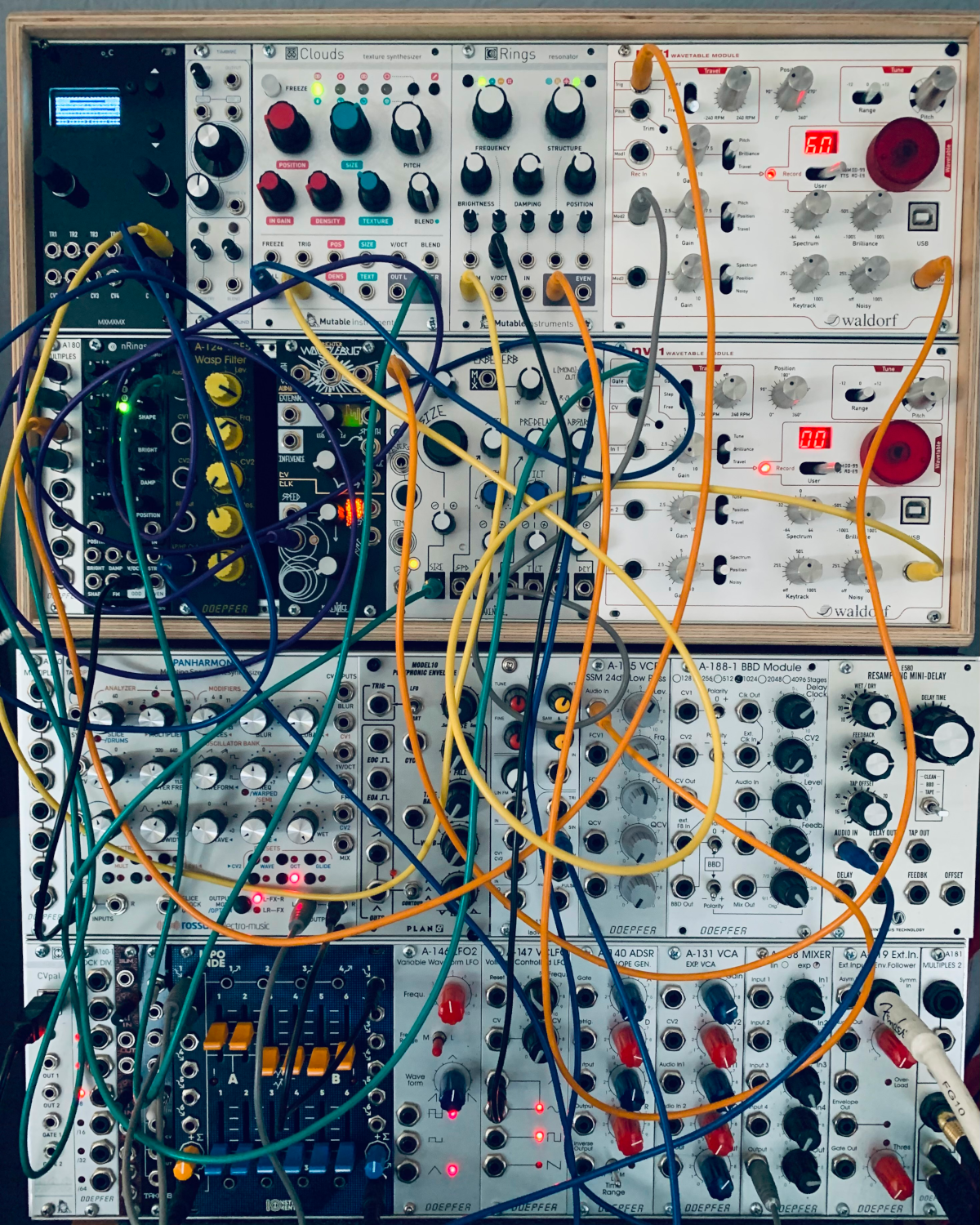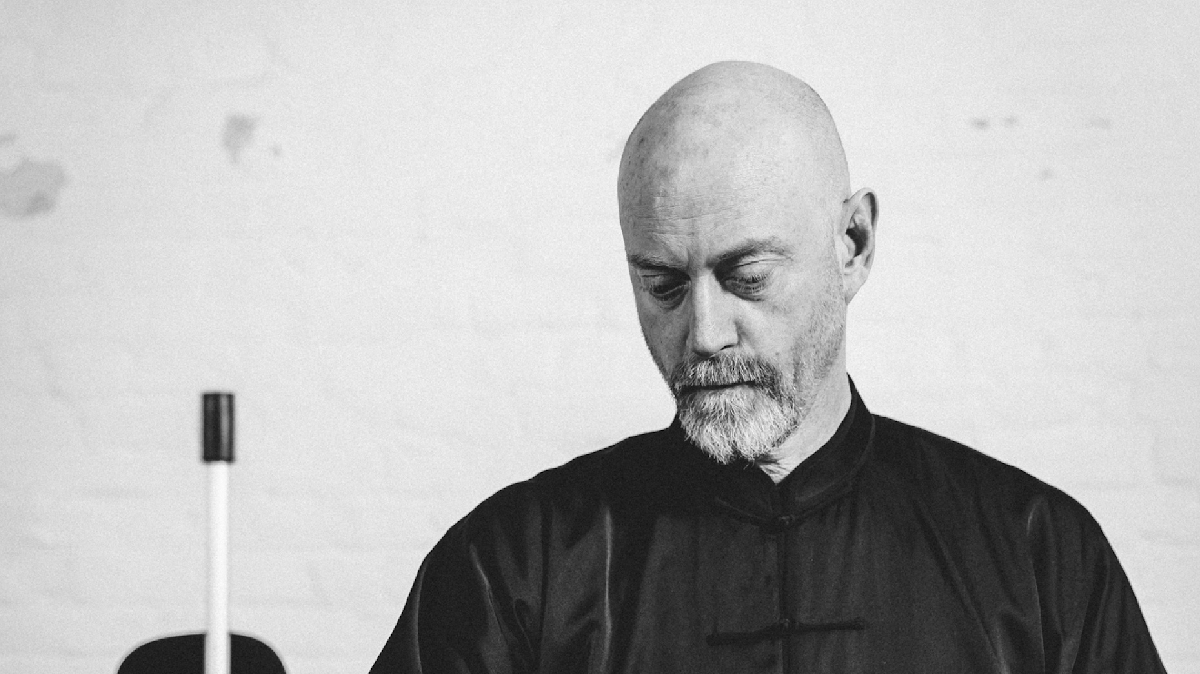 Experimental musician, singer and songwriter Siôn Orgon creates electroacoustic music, sound design and production in Cardiff.
Experimental musician, singer and songwriter Siôn Orgon creates electroacoustic music, sound design and production in Cardiff.
He has worked with the likes of Thighpaulsandra and is a member of Rocketgoldstar as well as collaborating over the years with groups and artists including Coil, Splintered, William D Drake, Peter Christopherson, Andrew Liles, Damo Suzuki, Faust and many more. Siôn also does sound design for BBC TV, as well as dance and theatre productions, films and installations.
Here, he talks through his immersion into modular synthesis and his session for Philippe Petit‘s Modulisme in particular:
When did you first become aware of modular synthesis as a particular way of making music, whether as part of electronic music in general or more specifically as its own particular format, and what did you think of it at the time?
The first modular synthesiser I had a go on was Thighpaulsandra‘s semi-modular ARP 2600. That was in 1999.I thought it was such a fantastic-sounding instrument, with endless sonic possibilities, and probably something I would never be able to afford. I always remember being impressed by how dirty things sounded, coming out of the ARP 2600’s internal speakers.
The marriage of modular synthesis with my other compositional ideas works incredibly well for me. I do try and shoehorn modular synthesis into most of the musical ideas I have. I like to process a lot of sounds through my Eurorack system, like guitar, vocals and field recordings.I’m also using cv/midi to trigger other synths I have here in my space, like the Moog Voyager, Waldorf Microwave, Roland V Synth etc. The sixty-minute album that I have created for Modulisme was the first time I tried to constrain my explorations specifically to just using my system, but I found myself wanting to add treated human elements like voice, guitar and piano frame to those pieces. It was definitely a great challenge.
What was your first module or system?
My first modules were Mutable Instruments Clouds, Tiptop Audio Happy Ending kit and the Doepfer A-119 external input.I started to buy Eurorack in 2015. I was looking for new ways of creating sounds. I was using Audiomulch a lot at this time and wanted to step away from a screen and get back to creating without the aid of a computer. Modular seemed to be the way forward.
How long did it take for you to become accustomed to patching your own synthesizer together out of its component parts?
Not long at all. It feels very natural to me to create using pathways. I took it one module at a time. I tend to learn each module as I buy them.Do you prefer single-maker systems (for example, Buchla, Make Noise, Erica Synths, Roland, etc) or making your own modular synthesizer out of individual components form whatever manufacturer that match your needs.
I’m open to all the different makes. I like the idea of mix and match, and find that different brands create different characters, feels and even looks. It is nice to see a Eurorack case full of various modules from all different manufacturers. Even though I adore Doepfer modules, a case full of them looks very clinical, like a piece of hospital machinery.
East Coast, West Coast or No-Coast (as Make Noise put it)? Or is it all irrelevant to how you approach synthesis?
It’s pretty much irrelevant to me. I will occasional attach a keyboard to my Eurorack system, but I’m surrounded by keyboard-based synths. It’s all about getting the result through whatever creative process arises.Do you tend to use pure modular systems, or do you bring in outside effects and devices when playing or recording?
It depends on what I’m trying to create. More often than not there is an external piece of gear attached like a microphone, guitar pedal, effect units, upright piano frame, or some of my hardware synthesisers. Some of the tracks I make will be pure modular-driven tracks, but 75% of the time there are other pieces of equipment involved.Do you find that you record straight with no overdubbing, or do you end up multi-tracking and editing tracks in post-production?
My system isn’t that big, so I find it hard to achieve my musical visions with just a Eurorack system. Especially when trying to make something interesting over a period of time. I multi-track a lot as well, but try to keep my editing to a minimum. My system is also synced up to other synths, samplers and machines in my studio, which helps in creating lots of layers of interest.
Do you pre-patch your system when playing live, or do you tend to improvise on the spot?
Pre-patch always, as I’m using the modular alongside other instruments. My system acts as the backbone to any live piece.Which module could you not do without, or which module do you you use the most in every patch?
My Ornament & Crime module running the Hemispheres software; it’s the beating heart of my system. It’s such a complex module that provides so much of the utility side of things.
What do you think that can only be achieved by modular synthesis that other forms of electronic music cannot or makes harder to do?
For me it’s the random happy accidents thing. You know, how you can just stumble across a sound or strange rhythm that feels right, with an incremental turn of a knob. Modular does this so well without making anything sound uniformed or constrained… the endless possibilities of not knowing what you are going to find. Have you used various forms of software modular (eg Reaktor Blocks, Softube Modular, VCVRack) or digital hardware with modular software editors (eg Nord Modular, Axoloti, Organelle), and if so what do you think of them?
Have you used various forms of software modular (eg Reaktor Blocks, Softube Modular, VCVRack) or digital hardware with modular software editors (eg Nord Modular, Axoloti, Organelle), and if so what do you think of them?
What module or system do you wish you had?
I think most modularists would love a Buchla system if they can afford it. But I’m really happy with Eurorack and the vast amount of attainable modules that are out there today. At the moment I’m looking at adding some of the Serge modules to my system.
Have you ever built a DIY module, or would you consider doing so?
I have built quite a few modules which I buy mostly from Thonk, my favourite being the DannySound Timbre module which works incredibly well with my Waldorf NW1 modules, as well as a Polaxis Talko, various mixers and VCAs, low pass gates, 4MS RCD, Befaco Delay, Fonitronik VCO and a Reverse Landfill Noise Generator, plus a few others. I really enjoy building modules as it gives me a greater insight in to how a particular module works.Which modular artist has influenced you the most in your own music?
There are probably two: Karlheinz Stockhausen and Thighpaulsandra (Tim Lewis).I discovered Stockhausen as a teenager and he really opened my eyes to the other side of music where there are no rules. I really like the Stockhausen albums Oktophonie and Gesang Der Jünglinge.
Thighpaulsandra has also been a huge influence on me. I feel very privileged to have worked with Tim for the last twenty-three years. He’s so enthusiastic about sound and is always keen to share ideas or techniques, especially when it comes to synthesis.
Can you hear the sound of individual modules when listening to music since you’ve been part of the modular world — how has it affected (or not) the way that you listen to music?
Yes I can, but it doesn’t affect me really. Its much like hearing a guitar part with a certain effects pedal attached. It’s all in the execution of the idea, regardless of the instrument that’s being used. For example, in my own modular creations I will use the Make Noise Erbe Verb. It’s an easily recognised module, but it’s so good at what it does.What have you been working on lately, and do you have any upcoming releases or performances?
I’m currently working on what will be my seventh studio album. Again it features all kinds of collaborators like Thighpaulsandra, Phillippe Petit, Mark Koch. I’m also working on a lot of sound design for theatre and television. Hopefully some European dates later on this year.Can you outline how you patched and performed your Modulisme session?
I can’t really outline the patches, as there are so many across the eleven tracks of my Modulisme session. I’m creating a lot of random CV and feedback patches, there’s some Karplus-Strong in there as well.
Who would your dream collaborator be for a Modulisme session or otherwise?
I think it would have to be Morton Subotnik or experimental saxophonist Colin Stetson. But then again, I’m really happy to collaborate with anyone that’s willing.*





